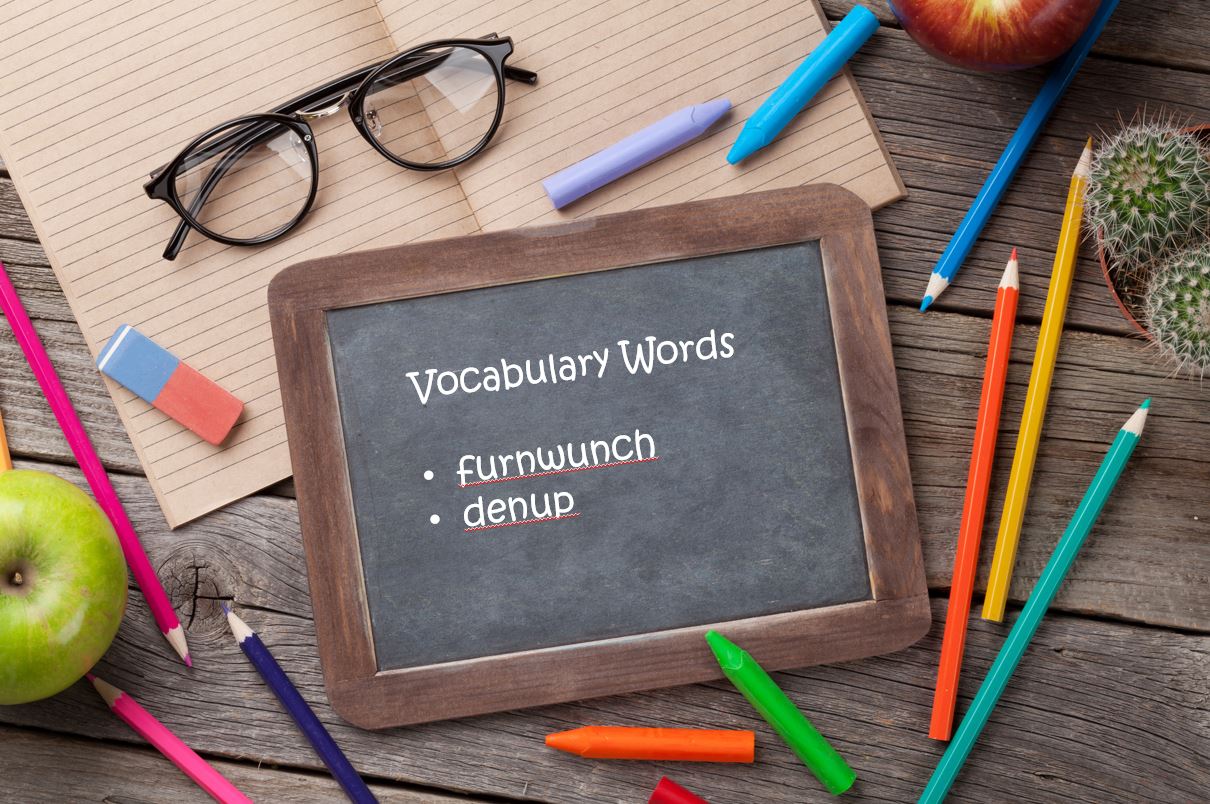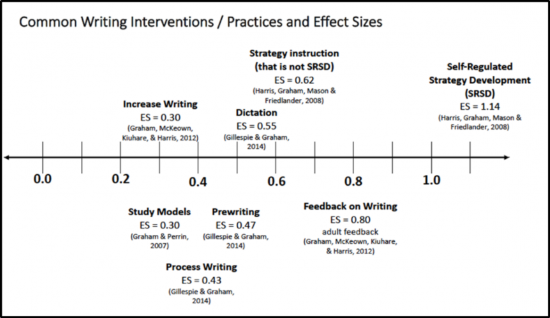How important is vocabulary in enhancing reading comprehension? To answer this complex question read the following paragraph to yourself.
The man leaned against the current as he waded, waist-deep, upstream. His hands steadied either end of the furnwunch balanced across his shoulders. He had moved about 90 yards from the denup where he had entered the stream. A few yards ahead, a part of the wooded bank had been replaced by an acnrid frud. He came abreast of it, and with effort, pressed the furnwunch up and over his head, and then set it on top of the frud. He placed his hands on his hips, pulled his elbows back and arched his back in an attempt to stretch out muscles that were knotted from the prolonged exertion.
On a scale from 1 to 5, (1=very low, 5=very high) assess your understanding. We anticipate that no one achieved a 5. Interestingly, only 4% of the vocabulary was unknown, but reading comprehension was affected significantly. (Hargis, 1987).
This exercise clearly demonstrates that understanding word meanings and their connections to other ideas and concepts is essential for comprehension. Because children with learning difficulties often have limited receptive and expressive overall vocabularies, effective vocabulary instruction is critical for them to become proficient readers. This article identifies some critical elements of effective vocabulary instruction, including which words to teach, vocabulary instruction guidelines, and student strategies that enhance vocabulary acquisition.
Which Words Should I Teach?
In their book Bringing Words to Life (2002), Beck, MeKeown & Kucan identify three major types of vocabulary words :
Tier 1: Basic high frequency words that are used everyday (e.g., dinner, phone, walk).
Tier 2: Mature high frequency words that are used across different domains of knowledge (summarize, fortunate, comprehend).
Tier 3: Domain low frequency words unique to specific content areas (stalagmites, peninsula, metamorphosis).
They suggest that teachers think about the “levels of utility” of different words when deciding which words to teach directly. Because Tier 1 words are easily learned in daily activities and Tier 3 words are low frequency, Tier 2 words have the highest utility. To identify Tier 2 words, teacher should ask these kinds of questions:
- How generally useful is this word?
- Is it a word that students will meet in other texts?
- How does it relate to ideas students know or have been learning?
- Could students explain the word using other words in their vocabulary?
Vocabulary Instruction Guidelines
Although many educators feel that students acquire vocabulary through context, struggling learners often do not. Therefore, teachers need to teach vocabulary directly to these students. Following are some guidelines for vocabulary instruction for students with learning difficulties from Vocabulary in the Elementary and Middle School (Johnson, 2001):
⇒ Teach vocabulary to the mastery level with repetition and multiple exposures.
⇒ Teach words that are related to each other, explicitly showing connections between words.
⇒ Have students write their own sentences only after they have participated in many teacher created lessons.
⇒ Use a dictionary with student friendly definitions like Collins Cobuild Dictionary.
Strategies to Enhance Vocabulary Acquisition
There is a large body of research about the effectiveness of teaching students self-directed learning strategies. Here are three strategies that are easy to learn and yield positive results in developing vocabulary.
- LINCS Strategy
The LINCS strategy (Ellis, 1992) is a way for students to independently generate keywords for targeted vocabulary. LINCS is an acronym for the following steps:
- List the parts. On an index card write the word on one side and the key parts of the definition on the back (e.g., “lethargic” on the front of card; “ sluggish, inactive” on the back of card)
- Imagine a picture. Describe a mental picture associated with the word.
- Note a reminding word: Think of a familiar word that sounds like the vocabulary word and note it on front of the card. (e.g., lazy slug)
- Construct a LINCS story: Make up a short story about the meaning of the word including the reminding word (e.g., The lazy slug wouldn’t get off the couch.) Include it on the back of the card.
- Self-Test. Say the vocabulary word. Look at the reminder word and generate the definition. Check to see that you are correct.
- Drama: Multisensory Approach to Vocabulary Development
A promising body of research has demonstrated that using drama activities is effective for increasing students’ vocabulary acquisition (Ranger, 1995). A drama vocabulary activity would use these steps. First, teach students several content vocabulary words. Next, write the target words on a strip of paper and place them in a bag or hat. Then have students take turns selecting words from the box and pantomiming the meaning while the rest of the students guess which word is being acted out.
- Practice Activity
Students need to practice once they have acquired new vocabulary words. Practice promotes automaticity of word recognition and the definition retrieval. An example of a practice activity is Write-On Response Boards: (Foil & Alber, 2002)
- Provide each student with a dry-erase board and a dry-erase marker
- Write a list of vocabulary words on the board to function as a word bank
- State a definition
- Have students write the corresponding word on their dry-erase boards
- Have students hold up their boards when the teacher gives the signal.
In summary, vocabulary directly affects reading and oral comprehension. Effective vocabulary instruction requires careful planning and an understanding that struggling learners often lack the skills to derive meaning from context. Effective vocabulary instruction actively involves students and focuses on developing a deep understanding of Tier 2 words through direct explicit vocabulary instruction and frequent opportunities to practice using new vocabulary words. With these tools, we can ensure all students are successful readers.
References
Beck, I.L., Mckeown, M.G. & Kucan, L. (2002). Bringing words to life: Robust vocabulary instruction. New York: Guilford Press.
Ellis, E. (1992). LINCS: A smarter strategy for vocabulary learning. Lawrence, KS: Edge.
Foil, Carolyn R. & Alber, Sheila R. (2002), Fun and Effective ways to Build Your Students’ Vocabulary. Intervention in school and Clinic, January 2002, 37, pp131-139.
Hargis, Charles H. (1987). Curriculum Based Assessment: A Primer. Springfield, IL: Charles C. Thomas, Publisher.
Johnson D. (2001). Vocabulary in the Elementary and Middle School. Boston: Allyn & Bacon.
Ranger, L. (!995). Improving reading comprehension through a multi-faceted approach utilizing drama. (ERIC Document Reproduction Service No. ED 380 758).



 Data-Driven Decision-Making
Data-Driven Decision-Making  Increasing Post-School Success through Interagency Collaboration
Increasing Post-School Success through Interagency Collaboration  How Can We Improve Deeper Learning for Students with Disabilities?
How Can We Improve Deeper Learning for Students with Disabilities?  Positive Classroom Management: Creating an Environment for Learning
Positive Classroom Management: Creating an Environment for Learning  Self-Determination Skills Empower Students of All Ages
Self-Determination Skills Empower Students of All Ages  Fidelity of Implementation: What is it and Why does it Matter?
Fidelity of Implementation: What is it and Why does it Matter?  Rethinking Classroom Assessment
Rethinking Classroom Assessment  A Three-Step Approach to Identifying Developmentally Appropriate Practices
A Three-Step Approach to Identifying Developmentally Appropriate Practices  Transforming Evidence-Based Practices into Usable Innovations: A Case Study with SRSD
Transforming Evidence-Based Practices into Usable Innovations: A Case Study with SRSD